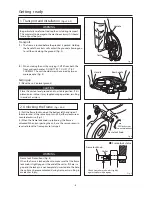
Be sure to use only recommended blades.
Code no.
Material
No. of teeth
Suitable for cutting
No. of
blades
included
(teeth / inch)
Steel pipe
Stainless
steel pipe
Steel
Conduit
475302
Alloy
14
≧
15A
-
Wall thickness
≧
6 mm
-
10
475303
18
≧
6A
-
Wall thickness
≧
4 mm
Thick steel
475312
High-speed
(Bimetal)
steel
14
≧
15A
Wall thickness
≧
4 mm
Wall thickness
≧
6 mm
-
5
475313
18
≧
6A
Wall thickness
≧
2 mm
Wall thickness
≧
4 mm
Thick steel
475314
24
-
Wall thickness
≦
2 mm
Wall thickness
≦
2 mm
Thin steel
T ypes of Blades (Optional extras)
Use the table below to select the blade and cutting load that are appropriate for the type, diameter,
wall thickness etc. of the material to be cut.
Material
Diameter
/ Wall
thickness
Alloy
High-speed steel
14-tooth
18-tooth
14-tooth
18-tooth
24-tooth
Steel pipe
≦
1"
L
L
L
L
1 /" ~ 2"
M
M
M
M
2 /" ~ 4"
H
H
H
H
Conduit
Thick steel
M
M
Thin steel
L
L
L
Steel (round
bar / section
steel)
≧
1.9mm
LL
2 ~ 3.4mm
M
M
3.5 ~ 4.9mm
M
M
≧
5mm
H
H
Stainless
steel
≧
1.2mm
LL
1.3 ~ 2mm
L
L
2.1 ~ 3.9mm
M
M
≧
4mm
H
Resin pipe
LL
LL
LL
LL
Cast-iron pipe
H
H
Selecting the Cutting Load and Blade
LL = ultra-light load L = light load M = medium load H = heavy load
Notes:
・
The figures in the table are examples only . Select the blade and cutting load to match the actual material to be cut.
・
When selecting the proper number of teeth in the blade, use the following guideline: thickness of material = 2 teeth.
.
- 5 -
Table 2
Table 3
Use
・
Cutting various mild steel materials such as a steel pipes, steel bars, etc.
Note: Do not use to cut hard materials such as quenched steel etc. or the blade will become extremely worn.
・
Cutting stainless steel and resin pipes
Note: Do not use heat-sensitive plastic materials. The heat generated when cutting may melt such materials,
which may clog the blade and cause the motor to burn.
1
4
1
2
Summary of Contents for MANTIS 120A
Page 23: ...XB125 120 E4 0802R0200 S S ...









































